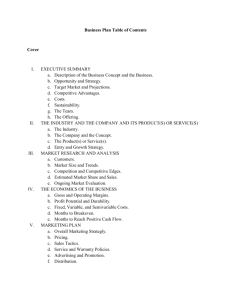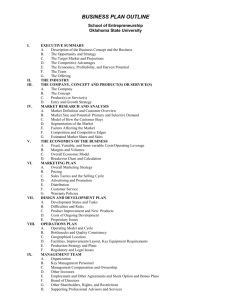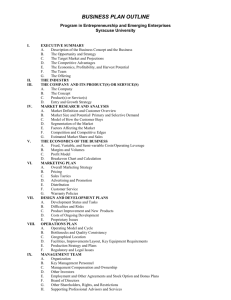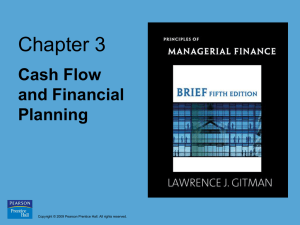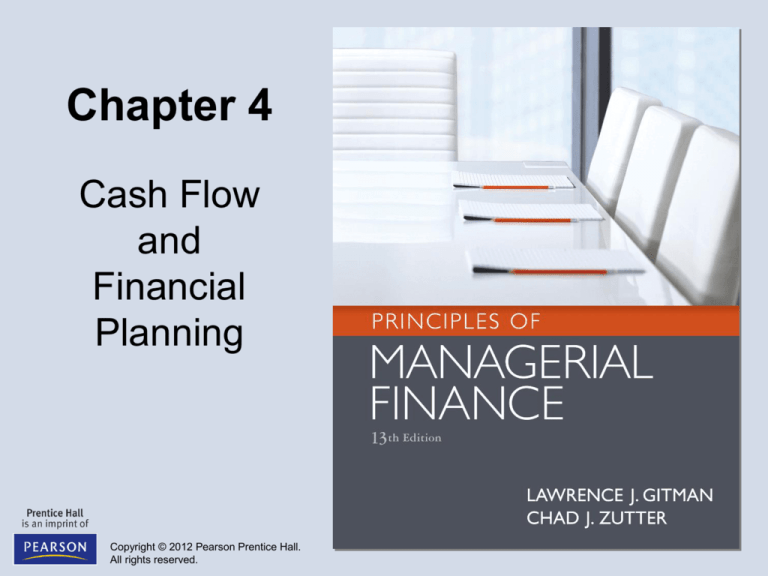
Chapter 4
Cash Flow
and
Financial
Planning
Copyright © 2012 Pearson Prentice Hall.
All rights reserved.
Learning Goals
LG1 Understand tax depreciation procedures and the effect
of depreciation on the firm’s cash flows.
LG2 Discuss the firm’s statement of cash flows, operating
cash flow, and free cash flow.
LG3 Understand the financial planning process, including
long-term (strategic) financial plans and short-term
(operating) financial plans.
© 2012 Pearson Prentice Hall. All rights reserved.
4-2
Learning Goals (cont.)
LG4 Discuss the cash-planning process and the
preparation, evaluation, and use of the cash budget.
LG5 Explain the simplified procedures used to prepare and
evaluate the pro forma income statement and the pro
forma balance sheet.
LG6 Evaluate the simplified approaches to pro forma
financial statement preparation and the common uses
of pro forma statements.
© 2012 Pearson Prentice Hall. All rights reserved.
4-3
Analyzing the Firm’s Cash Flow
• Cash flow (as opposed to accounting “profits”) is the
primary ingredient in any financial valuation model.
• From an accounting perspective, cash flow is summarized
in a firm’s statement of cash flows.
• From a financial perspective, firms often focus on both
operating cash flow, which is used in managerial
decision-making, and free cash flow, which is closely
monitored by participants in the capital market.
© 2012 Pearson Prentice Hall. All rights reserved.
4-4
Depreciation
• Depreciation is the portion of the costs of fixed assets
charged against annual revenues over time.
• Depreciation for tax purposes is determined by using the
modified accelerated cost recovery system (MACRS).
• On the other hand, a variety of other depreciation methods
are often used for reporting purposes.
© 2012 Pearson Prentice Hall. All rights reserved.
4-5
Depreciation: An Example
Baker Corporation acquired a new machine at a cost of
$38,000, with installation costs of $2,000. When the
machine is retired from service, Baker expects that it will
sell it for scrap metal and receive $1,000.
What is the depreciable value of the machine?
– Regardless of its expected salvage value, the depreciable value
of the machine is $40,000: $38,000 cost + $2,000 installation
cost.
© 2012 Pearson Prentice Hall. All rights reserved.
4-6
Depreciation: Depreciable
Value and Depreciable Life
• Under the basic MACRS procedures, the depreciable
value of an asset is its full cost, including outlays for
installation.
• No adjustment is required for expected salvage value.
• For tax purposes, the depreciable life of an asset is
determined by its MACRS recovery predetermined
period.
• MACRS property classes and rates are shown in
Table 4.1 and Table 4.2 on the following slides.
© 2012 Pearson Prentice Hall. All rights reserved.
4-7
Table 4.1 First Four Property
Classes under MACRS
© 2012 Pearson Prentice Hall. All rights reserved.
4-8
Table 4.2 Rounded Depreciation Percentages by
Recovery Year Using MACRS for First Four
Property Classes
© 2012 Pearson Prentice Hall. All rights reserved.
4-9
Depreciation: An Example
Baker Corporation acquired, for an installed cost of $40,000, a
machine having a recovery period of 5 years. Using the applicable
MACRS rates, the depreciation expense each year is as follows:
© 2012 Pearson Prentice Hall. All rights reserved.
4-10
Developing the Statement of
Cash Flows
• The statement of cash flows summarizes the firm’s cash
flow over a given period of time.
• Firm’s cash flows fall into three categories:
– Operating flows: cash flows directly related to sale and
production of the firm’s products and services.
– Investment flows: cash flows associated with purchase and sale
of both fixed assets and equity investments in other firms.
– Financing flows: cash flows that result from debt and equity
financing transactions; include incurrence and repayment of
debt, cash inflow from the sale of stock, and cash outflows to
repurchase stock or pay cash dividends.
© 2012 Pearson Prentice Hall. All rights reserved.
4-11
Table 4.3
Inflows and Outflows of Cash
© 2012 Pearson Prentice Hall. All rights reserved.
4-12
Table 4.4 Baker Corporation
2012 Income Statement ($000)
© 2012 Pearson Prentice Hall. All rights reserved.
4-13
Table 4.5a Baker Corporation
Balance Sheets ($000)
© 2012 Pearson Prentice Hall. All rights reserved.
4-14
Table 4.5b Baker Corporation
Balance Sheets ($000)
© 2012 Pearson Prentice Hall. All rights reserved.
4-15
Table 4.6 Baker Corporation Statement of Cash
Flows ($000) for the Year Ended December 31,
2012
© 2012 Pearson Prentice Hall. All rights reserved.
4-16
Interpreting Statement of
Cash Flows
• The statement of cash flows ties the balance sheet at the
beginning of the period with the balance sheet at the end
of the period after considering the performance of the
firm during the period through the income statement.
• The net increase (or decrease) in cash and marketable
securities should be equivalent to the difference between
the cash and marketable securities on the balance sheet at
the beginning of the year and the end of the year.
© 2012 Pearson Prentice Hall. All rights reserved.
4-17
Operating Cash Flow
• A firm’s operating Cash Flow (OCF) is the cash flow
a firm generates from normal operations—from the
production and sale of its goods and services.
• OCF may be calculated as follows:
NOPAT = EBIT (1 – T)
OCF = NOPAT + Depreciation
OCF = [EBIT (1 – T)] + Depreciation
© 2012 Pearson Prentice Hall. All rights reserved.
4-18
Operating Cash Flow (cont.)
• Substituting for Baker Corporation, we get:
OCF = [$370 (1 – .40)] + $100 = $322
• Thus, we can conclude that Baker’s operations are
generating positive operating cash flows.
© 2012 Pearson Prentice Hall. All rights reserved.
4-19
Free Cash Flow
• Free cash flow (FCF) is the amount of cash flow
available to investors (creditors and owners) after the firm
has met all operating needs and paid for investments in
net fixed assets (NFAI) and net current assets (NCAI).
FCF = OCF – NFAI – NCAI
• Where:
NFAI = Change in net fixed assets + Depreciation
NCAI = Change in CA – Change in (A/P + Accruals)
© 2012 Pearson Prentice Hall. All rights reserved.
4-20
Free Cash Flow (cont.)
• Using Baker Corporation we get:
NFAI = [($1,200 – $1,000) + $100] = $300
NCAI = [($2,000 – $1,900) + ($800 - $700)] = $0
FCF = $322 – $300 – $0 = $22
• Thus, the firm generated adequate cash flow to cover all
of its operating costs and investments and had free cash
flow available to pay investors.
© 2012 Pearson Prentice Hall. All rights reserved.
4-21
Focus on Practice
Free Cash Flow at Cisco Systems
– On May 13, 2010, Cisco Systems reported earnings per share of $0.42 for the
most recent quarter, ahead of the expectations of Wall Street experts who had
projected EPS of $0.39.
– In subsequent analysis, one analyst observed that of the three cents by which
Cisco beat the street’s forecast, one cent could be attributed to the fact that the
quarter was 14 weeks rather than the more typical 13 weeks. Another penny
was attributable to unusual tax gains, and the third was classified with the
somewhat vague label, “other income.”
– Free cash flow is often considered a more reliable measure of a company’s
income than reported earnings. What are some possible ways that corporate
accountants might be able to change their earnings to portray a more
favorable earnings statement?
© 2012 Pearson Prentice Hall. All rights reserved.
4-22
The Financial Planning Process
• The financial planning process begins with long-term,
or strategic, financial plans that in turn guide the
formulation of short-term, or operating, plans and
budgets.
• Two key aspects of financial planning are cash planning
and profit planning.
– Cash planning involves the preparation of the firm’s cash
budget.
– Profit planning involves preparation of pro forma statements.
© 2012 Pearson Prentice Hall. All rights reserved.
4-23
The Financial Planning Process:
Long-Term (Strategic) Financial Plans
• Long-term (strategic) financial plans lay out a
company’s planned financial actions and the anticipated
impact of those actions over periods ranging from 2 to 10
years.
• Firms that are subject to high degrees of operating
uncertainty, relatively short production cycles, or both,
tend to use shorter planning horizons.
• These plans are one component of a company’s integrated
strategic plan (along with production and marketing
plans) that guide a company toward achievement of its
goals.
© 2012 Pearson Prentice Hall. All rights reserved.
4-24
The Financial Planning Process:
Long-Term (Strategic) Financial Plans
• Long-term financial plans consider a number of financial
activities including:
– Proposed fixed asset investments
– Research and development activities
– Marketing and product development
– Capital structure
– Sources of financing
• These plans are generally supported by a series of annual
budgets and profit plans.
© 2012 Pearson Prentice Hall. All rights reserved.
4-25
Focus on Ethics
How Much Is a CEO Worth?
– Bob Nardelli abruptly resigned his position as Home Depot CEO on
January 3, 2007.
– Nardelli’s total severance package amounted to $210 million, including
$55.3 million of life insurance coverage, reimbursement of $1.3 million of
personal taxes related to the life insurance, $50,000 to cover his legal fees,
$33.8 million in cash due July 3, 2007, an additional $18 million over 4 years
for abiding by the terms of the deal, and the balance of the package from
accelerated vesting of stock options.
– In addition, Nardelli and his family would receive health-care benefits from
the company for the next 3 years.
– What are some possible activities that Nardelli must avoid in order to reap the
additional $18 million over 4 years?
© 2012 Pearson Prentice Hall. All rights reserved.
4-26
The Financial Planning Process:
Short-Term (Operating) Financial Plans
• Short-term (operating) financial plans specify shortterm financial actions and the anticipated impact of those
actions.
• Key inputs include the sales forecast and other operating
and financial data.
• Key outputs include operating budgets, the cash budget,
and pro forma financial statements.
• This process is described graphically on the following
slide.
© 2012 Pearson Prentice Hall. All rights reserved.
4-27
Figure 4.1
Short-Term Financial Planning
© 2012 Pearson Prentice Hall. All rights reserved.
4-28
The Financial Planning Process:
Short-Term (Operating) Financial Plans
• As indicated in the previous exhibit, short-term financial
planning begins with a sales forecast.
• From this sales forecast, production plans are developed
that consider lead times and raw material requirements.
• From the production plans, direct labor, factory overhead,
and operating expense estimates are developed.
• From this information, the pro forma income statement
and cash budget are prepared—ultimately leading to the
development of the pro forma balance sheet.
© 2012 Pearson Prentice Hall. All rights reserved.
4-29
Personal Finance Example
First step – define your goals.
– Short-term (1 year)
– Intermediate-term (2–5 years)
– Long-term (6+ years)
– Each goal should be clearly defined and have a priority, time
frame, and cost estimate.
– For example, a college senior’s intermediate-term goal in 2012
might include earning a master’s degree at a cost of $40,000 by
2012, and his or her long-term goal might be to buy a
condominium at a cost of $125,000 by 2016.
© 2012 Pearson Prentice Hall. All rights reserved.
4-30
Cash Planning: Cash Budgets
• The cash budget or cash forecast is a statement of the
firm’s planned inflows and outflows of cash that is used to
estimate its short-term cash requirements.
• Typically, the cash budget is designed to cover a 1-year
period, divided into smaller time intervals.
• The more seasonal and uncertain a firm’s cash flows, the
greater the number of intervals.
© 2012 Pearson Prentice Hall. All rights reserved.
4-31
Cash Planning:
Cash Budgets (cont.)
• A sales forecast is a prediction of the sales activity during a given
period, based on external and/or internal data.
• The sales forecast is then used as a basis for estimating the monthly
cash flows that will result from projected sales and from outlays
related to production, inventory, and sales.
• The sales forecast may be based on an analysis of external data,
internal data, or a combination of the two.
– An external forecast is a sales forecast based on the relationships observed
between the firm’s sales and certain key external economic indicators.
– An internal forecast is a sales forecast based on a buildup, or consensus, of
sales forecasts through the firm’s own sales channels.
© 2012 Pearson Prentice Hall. All rights reserved.
4-32
Table 4.7 The General Format of
the Cash Budget
© 2012 Pearson Prentice Hall. All rights reserved.
4-33
Cash Planning: Cash Budgets
An Example: Coulson Industries
Coulson Industries, a defense contractor, is developing a
cash budget for October, November, and December.
Coulson’s sales in August and September were $100,000
and $200,000 respectively. Sales of $400,000, $300,000 and
$200,000 have been forecast for October, November, and
December. Historically, 20% of the firm’s sales have been
for cash, 50% have been collected after 1 month, and the
remaining 30% after 2 months. In December, Coulson will
receive a $30,000 dividend from stock in a subsidiary.
© 2012 Pearson Prentice Hall. All rights reserved.
4-34
Table 4.8 A Schedule of Projected Cash
Receipts for Coulson Industries ($000)
© 2012 Pearson Prentice Hall. All rights reserved.
4-35
Cash Planning: Cash Budgets
An Example: Coulson Industries (cont.)
Coulson has also gathered the relevant information for the
development of a cash disbursement schedule. Purchases
will represent 70% of sales—10% will be paid immediately
in cash, 70% is paid the month following the purchase, and
the remaining 20% is paid two months following the
purchase. The firm will also expend cash on rent, wages and
salaries, taxes, capital assets, interest, dividends, and a
portion of the principal on its loans. The resulting
disbursement schedule thus follows.
© 2012 Pearson Prentice Hall. All rights reserved.
4-36
Table 4.9 A Schedule of Projected Cash
Disbursements for Coulson Industries ($000)
© 2012 Pearson Prentice Hall. All rights reserved.
4-37
Cash Planning: Cash Budgets
An Example: Coulson Industries (cont.)
The Cash Budget for Coulson Industries can be derived by
combining the receipts budget with the disbursements
budget. At the end of September, Coulson’s cash balance
was $50,000, notes payable was $0, and marketable
securities balance was $0. Coulson also wishes to maintain a
minimum cash balance of $25,000. As a result, it will have
excess cash in October, and a deficit of cash in November
and December. The resulting cash budget follows.
© 2012 Pearson Prentice Hall. All rights reserved.
4-38
Table 4.10 A Cash Budget for
Coulson Industries ($000)
© 2012 Pearson Prentice Hall. All rights reserved.
4-39
Evaluating the Cash Budget
• Cash budgets indicate the extent to which cash shortages
or surpluses are expected in the months covered by the
forecast.
• The excess cash of $22,000 in October should be invested
in marketable securities. The deficits in November and
December need to be financed.
© 2012 Pearson Prentice Hall. All rights reserved.
4-40
Personal Finance Example
• Because individuals receive only a finite amount of
income (cash inflow) during a given period, they need to
prepare budgets in order to make sure they can cover their
expenses (cash outflows) during the period.
© 2012 Pearson Prentice Hall. All rights reserved.
4-41
Coping with Uncertainty in the
Cash Budget
• One way to cope with cash budgeting uncertainty is to
prepare several cash budgets based on several forecasted
scenarios (e.g., pessimistic, most likely, optimistic).
• From this range of cash flows, the financial manager can
determine the amount of financing necessary to cover the
most adverse situation.
• This method will also provide a sense of the riskiness of
alternatives.
• An example of this sort of “sensitivity analysis” for
Coulson Industries is shown on the following slide.
© 2012 Pearson Prentice Hall. All rights reserved.
4-42
Table 4.11 A Scenario Analysis of
Coulson Industries’ Cash Budget ($000)
© 2012 Pearson Prentice Hall. All rights reserved.
4-43
Profit Planning:
Pro Forma Statements
• Pro forma financial statements are projected, or
forecast, income statements and balance sheets.
• The inputs required to develop pro forma statements using
the most common approaches include:
– Financial statements from the preceding year
– The sales forecast for the coming year
– Key assumptions about a number of factors
• The development of pro forma financial statements will
be demonstrated using the financial statements for Vectra
Manufacturing.
© 2012 Pearson Prentice Hall. All rights reserved.
4-44
Table 4.12 Vectra Manufacturing’s
Income Statement for the Year Ended
December 31, 2012
© 2012 Pearson Prentice Hall. All rights reserved.
4-45
Table 4.13 Vectra Manufacturing’s
Balance Sheet, December 31, 2012
© 2012 Pearson Prentice Hall. All rights reserved.
4-46
Table 4.14 2010 Sales Forecast
for Vectra Manufacturing
© 2012 Pearson Prentice Hall. All rights reserved.
4-47
Profit Planning: Pro Forma
Financial Statements (cont.)
Step 1: Start with a Sales Forecast (cont.)
– The previous sales forecast is based on an increase in price from
$20 to $25 per unit for Model X and from $40 to $50 per unit
for Model Y.
– These increases are required to cover anticipated increases in
various costs, including labor, materials, & overhead.
© 2012 Pearson Prentice Hall. All rights reserved.
4-48
Profit Planning: Pro Forma
Financial Statements (cont.)
Step 2: Preparing the Pro Forma Income Statement
– A simple method for developing a pro forma income statement
is the percent-of-sales method.
– This method starts with the sales forecast and then expresses the
cost of goods sold, operating expenses, interest expense, and
other accounts as a percentage of projected sales.
– Using the Vectra example, the easiest way to do this is to recast
the historical income statement as a percentage of sales.
© 2012 Pearson Prentice Hall. All rights reserved.
4-49
Profit Planning: Pro Forma
Financial Statements (cont.)
Step 2: Preparing the Pro Forma Income Statement (cont.)
– By using dollar values taken from Vectra’s 2012 income
statement (Table 4.12), we find that these percentages are
© 2012 Pearson Prentice Hall. All rights reserved.
4-50
Table 4.15 A Pro Forma Income Statement, Using the
Percent-of-Sales Method, for Vectra Manufacturing for the
Year Ended December 31, 2013
© 2012 Pearson Prentice Hall. All rights reserved.
4-51
Profit Planning: Pro Forma
Financial Statements (cont.)
Step 2: Preparing the Pro Forma Income Statement (cont.)
– Clearly, some of the firm’s expenses will increase with the level
of sales while others will not.
– the use of past cost and expense ratios generally tends to
understate profits when sales are increasing. (Likewise, it tends
to overstate profits when sales are decreasing.)
– The best way to generate a more realistic pro forma income
statement is to segment the firm’s expenses into fixed and
variable components, as illustrated in the following example.
© 2012 Pearson Prentice Hall. All rights reserved.
4-52
Profit Planning: Pro Forma
Financial Statements (cont.)
Step 3: Preparing the Pro Forma Balance Sheet
– The judgmental approach is a simplified approach for
preparing the pro forma balance sheet under which the firm
estimates the values of certain balance sheet accounts and uses
its external financing as a balancing, or “plug,” figure.
– To apply this method to Vectra Manufacturing, a number of
simplifying assumptions must be made.
© 2012 Pearson Prentice Hall. All rights reserved.
4-53
Profit Planning: Pro Forma
Financial Statements (cont.)
Step 3: Preparing the Pro Forma Balance Sheet (cont.)
1. A minimum cash balance of $6,000 is desired.
2. Marketable securities will remain at their current level of $4,000.
3. Accounts receivable will be approximately $16,875 which
represents 45 days of sales (about 1/8th of a year) on average
[(45/360) $135,000].
4. Ending inventory will remain at about $16,000. 25% ($4,000)
represents raw materials and 75% ($12,000) is finished goods.
5. A new machine costing $20,000 will be purchased. Total
depreciation will be $8,000. Adding $20,000 to existing net fixed
assets of $51,000 and subtracting the $8,000 depreciation yields a
net fixed assets figure of $63,000.
© 2012 Pearson Prentice Hall. All rights reserved.
4-54
Profit Planning: Pro Forma
Financial Statements (cont.)
Step 3: Preparing the Pro Forma Balance Sheet (cont.)
6. Purchases will be $40,500 which represents 30% of annual sales
(30% $135,000). Vectra takes about 72 days to pay on its accounts
payable. As a result, accounts payable will equal $8,100 [(72/360)
$40,500].
7. Taxes payable will be $455 which represents one-fourth of the 2013
tax liability.
8. Notes payable will remain unchanged at $8,300.
9. There will be no change in other current liabilities, long-term debt,
and common stock.
10. Retained earnings will change in accordance with the pro forma
income statement.
© 2012 Pearson Prentice Hall. All rights reserved.
4-55
Table 4.16 A Pro Forma Balance Sheet,
Using the Judgmental Approach, for
Vectra Manufacturing (December 31, 2013)
© 2012 Pearson Prentice Hall. All rights reserved.
4-56
Evaluation of Pro Forma
Statements
• The major weaknesses of the approaches to pro forma
statement development outlined above lie in two
assumptions:
– That the firm’s past financial performance will be replicated in
the future
– That certain variables (such as cash, accounts receivable, and
inventories) can be forced to take on certain “desired” values.
• These assumptions cannot be justified solely on the basis
of their ability to simplify the calculations involved.
© 2012 Pearson Prentice Hall. All rights reserved.
4-57
Evaluation of Pro Forma
Statements (cont.)
However pro forma statements are prepared, analysts must
understand how to use them to make financial decisions.
– Financial managers and lenders can use pro forma statements to
analyze the firm’s inflows and outflows of cash, as well as its
liquidity, activity, debt, profitability, and market value.
– Various ratios can be calculated from the pro forma income
statement and balance sheet to evaluate performance.
– Cash inflows and outflows can be evaluated by preparing a pro
forma statement of cash flows.
– After analyzing the pro forma statements, the financial manager
can take steps to adjust planned operations to achieve short-term
financial goals.
© 2012 Pearson Prentice Hall. All rights reserved.
4-58
Review of Learning Goals
LG1
Understand tax depreciation procedures and the effect of
depreciation on the firm’s cash flows.
– Depreciation is an important factor affecting a firm’s cash flow. An
asset’s depreciable value and depreciable life are determined by using
the MACRS standards in the federal tax code.
LG2
Discuss the firm’s statement of cash flows, operating cash
flow, and free cash flow.
– The statement of cash flows is divided into operating, investment,
and financing flows. It reconciles changes in the firm’s cash flows
with changes in cash and marketable securities for the period. From a
strict financial point of view, a firm’s operating cash flow is defined
to exclude interest. Of greater importance is a firm’s free cash flow,
which is the amount of cash flow available to creditors and owners.
© 2012 Pearson Prentice Hall. All rights reserved.
4-59
Review of Learning Goals
(cont.)
LG3
Understand the financial planning process, including long-term
(strategic) financial plans and short-term (operating) financial
plans.
– The two key aspects of the financial planning process are cash planning
and profit planning. Long-term (strategic) financial plans act as a guide
for preparing short-term (operating) financial plans. Long-term plans
tend to cover periods ranging from 2 to 10 years; short-term plans most
often cover a 1- to 2-year period.
© 2012 Pearson Prentice Hall. All rights reserved.
4-60
Review of Learning Goals
(cont.)
LG4
Discuss the cash-planning process and the preparation,
evaluation, and use of the cash budget.
– The cash-planning process uses the cash budget, based on a sales
forecast, to estimate short-term cash surpluses and shortages. The cash
budget nets cash receipts and disbursements for each period to calculate
net cash flow. Ending cash is estimated by adding beginning cash to the
net cash flow. By subtracting the desired minimum cash balance from
the ending cash, the firm can determine required total financing or the
excess cash balance.
© 2012 Pearson Prentice Hall. All rights reserved.
4-61
Review of Learning Goals
(cont.)
LG5
Explain the simplified procedures used to prepare and evaluate
the pro forma income statement and the pro forma balance
sheet.
– A pro forma income statement can be developed by calculating past
percentage relationships between certain cost and expense items and the
firm’s sales and then applying these percentages to forecasts.
– Under the judgmental approach, the values of certain balance sheet
accounts are estimated and the firm’s external financing is used as a
balancing, or “plug,” figure.
© 2012 Pearson Prentice Hall. All rights reserved.
4-62
Review of Learning Goals
(cont.)
LG6
Evaluate the simplified approaches to pro forma financial
statement preparation and the common uses of pro forma
statements.
– Simplified approaches for preparing pro forma statements assume that
the firm’s past financial condition is an accurate indicator of the future.
Pro forma statements are commonly used to forecast and analyze the
firm’s level of profitability and overall financial performance so that
adjustments can be made to planned operations to achieve short-term
financial goals.
© 2012 Pearson Prentice Hall. All rights reserved.
4-63
Chapter Resources on
MyFinanceLab
• Chapter Cases
• Group Exercises
• Critical Thinking Problems
© 2012 Pearson Prentice Hall. All rights reserved.
4-64


